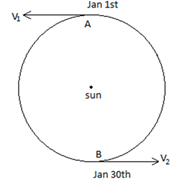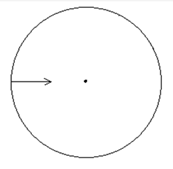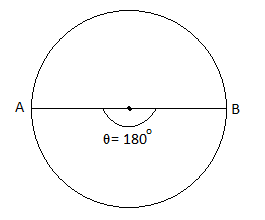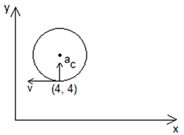12th Grade > Physics
KINEMATICS MCQs
Circular Kinematics
Total Questions : 41
| Page 2 of 5 pages
Answer: Option D. -> The instantaneous acceleration of the earth points towards the sun.
:
D

(a) we can see there is a displacement from A to B .∴ average velocity cannot be zero
(b) aavg=→v2−→v1t=30^i−(−30^i)6months=606×30×3600km/s2 which is already not 60 km/s2
(c) average speed is not zero as total distance covered is not zero
(d) The instantaneous acceleration will point to the sun as the above described motion is uniform circular motion with sun at the centre of the circular path.
:
D

(a) we can see there is a displacement from A to B .∴ average velocity cannot be zero
(b) aavg=→v2−→v1t=30^i−(−30^i)6months=606×30×3600km/s2 which is already not 60 km/s2
(c) average speed is not zero as total distance covered is not zero
(d) The instantaneous acceleration will point to the sun as the above described motion is uniform circular motion with sun at the centre of the circular path.
Answer: Option B. -> r1 : r2
:
B
Centripetal acceleration,
a = w2 r = (2πT)2. r
∴ a1a2 = r1r2
:
B
Centripetal acceleration,
a = w2 r = (2πT)2. r
∴ a1a2 = r1r2
Answer: Option A. -> 0.0336 m/s2
:
A
Earth completes one rotation in 24 hrs
i.e. angle swept =2π
in time=24 hrs
⇒angularvelocity=ω=2π24×60×60
Centripetal acceleration =ω2R
⇒(2π24×60×60)2×6400×1000
(∵R=Diameter2)
⇒0.0336m/s2
:
A
Earth completes one rotation in 24 hrs
i.e. angle swept =2π
in time=24 hrs
⇒angularvelocity=ω=2π24×60×60
Centripetal acceleration =ω2R
⇒(2π24×60×60)2×6400×1000
(∵R=Diameter2)
⇒0.0336m/s2
Question 14.
A carnival merry-go-round rotates about a vertical axis at a constant rate. A man standing on the edge has a constant speed of 3 m/s and a centripetal acceleration →a of magnitude 2 m/s2. Position vector →r locates him relative to the rotation axis.
What is the magnitude of →r ? What is the direction of →r when →a is directed due east?
A carnival merry-go-round rotates about a vertical axis at a constant rate. A man standing on the edge has a constant speed of 3 m/s and a centripetal acceleration →a of magnitude 2 m/s2. Position vector →r locates him relative to the rotation axis.
What is the magnitude of →r ? What is the direction of →r when →a is directed due east?
:
v=rω
v1=r1ω=2×2=4cmsec
v2=r2ω=1×2=2cmsec
v1v2=42=2
:
The angular velocity is
ω=vr=10ms20cm=50rads
Answer: Option C. -> −v2Rcosθ^i+v2Rsinθ^j
:
C
→r=Rcosθ^j
∴d→rdt=−Rsinθdθdt^i+Rcosθdθdt^j
⇒→v=−Rωsinθ^i+Rωcosθ^j
(asω=dθdtandd→rdt=→v)
⇒d→vdt=→a=Rωcosθdθdt^i+Rω(−sinθ)dθdt^j
⇒dsdt≡dθrdt=rdθdt=rω
∴ωordθdtisconstant
∴→v=−Rω2cosθ^i−Rω2sinθ^j
Substituting ω=vR
→a=−v2Rcosθ^i−−v2Rsinθ^j
:
C
→r=Rcosθ^j
∴d→rdt=−Rsinθdθdt^i+Rcosθdθdt^j
⇒→v=−Rωsinθ^i+Rωcosθ^j
(asω=dθdtandd→rdt=→v)
⇒d→vdt=→a=Rωcosθdθdt^i+Rω(−sinθ)dθdt^j
⇒dsdt≡dθrdt=rdθdt=rω
∴ωordθdtisconstant
∴→v=−Rω2cosθ^i−Rω2sinθ^j
Substituting ω=vR
→a=−v2Rcosθ^i−−v2Rsinθ^j
Question 19. A particle moves horizontally in uniform circular motion, over a horizontal xy plane. At one instant, it moves through the point at coordinates (4.00 m, 4.00 m) with a velocity of -5.00^i m/s and an acceleration of + 12.5^j m/s2. What are the x and y coordinates of the center of the circular path?
Answer: Option A. -> 2πvT
:
A
Acceleration =ω2r=v24=ωv=2πTv
:
A
Acceleration =ω2r=v24=ωv=2πTv




















